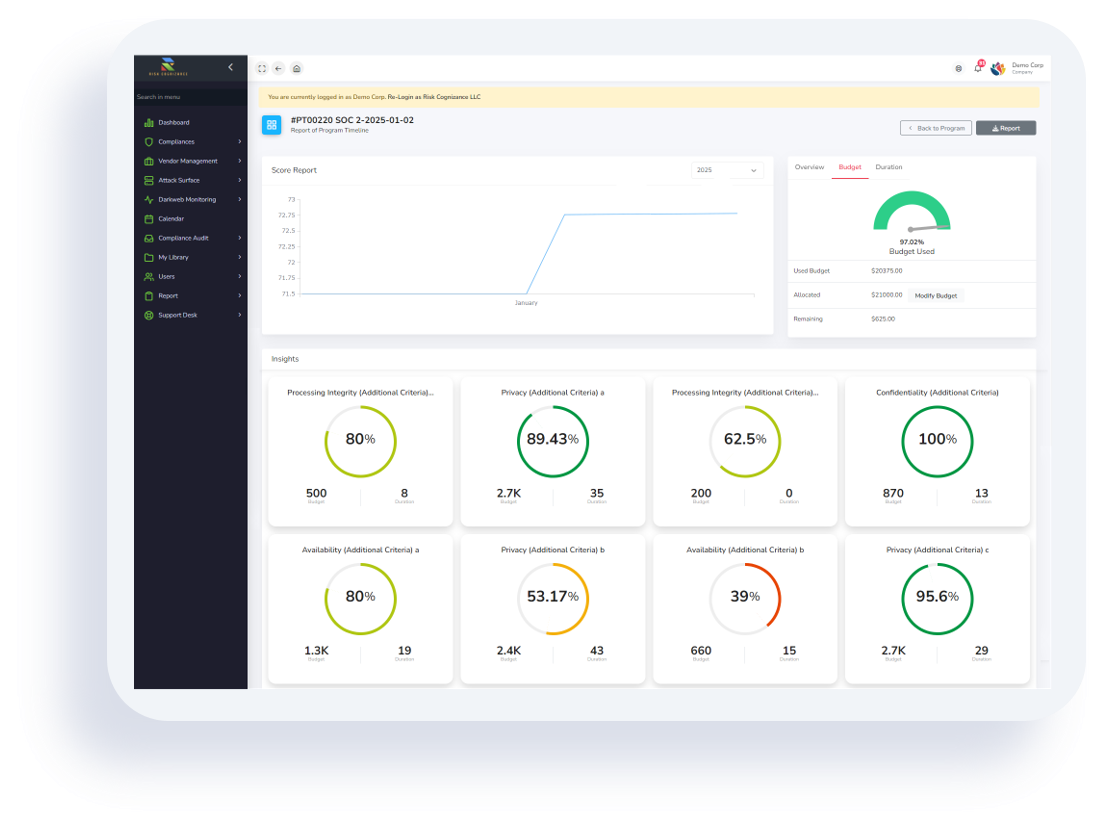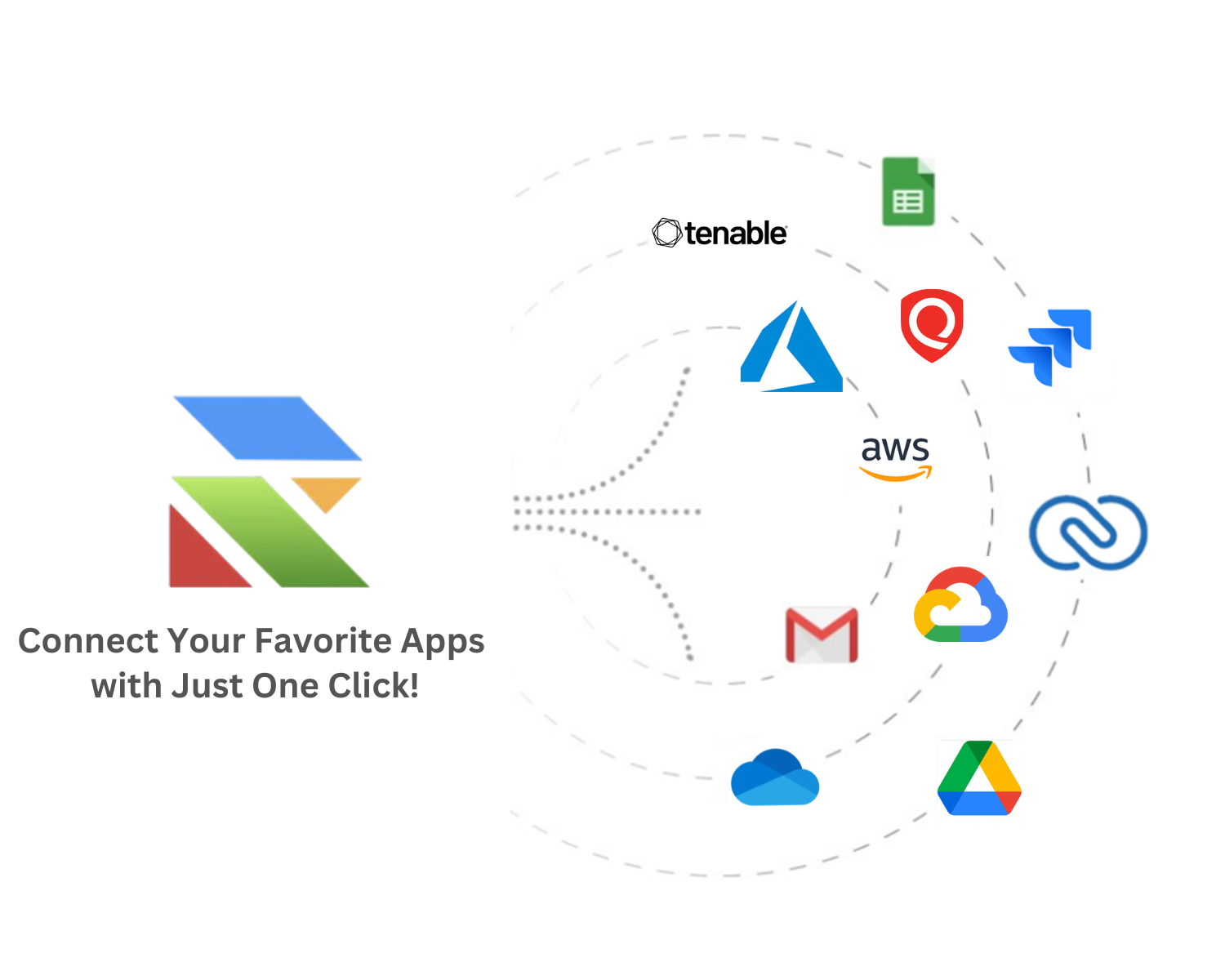
Risk Cognizance Reimagines Cyber Security Operations with Agentic AI
NEW YORK, NY – July 19, 2025 – Risk Cognizance, a leading provider of Governance, Risk, and Compliance (GRC) software solutions, today announced a groundbreaking evolution in cybersecurity operations with the integration of advanced agentic AI capabilities across its platform. This strategic move redefines how organizations can proactively detect, respond to, and manage cyber threats, shifting from reactive, manual processes to autonomous, intelligent defense.
Traditional cybersecurity operations are frequently overwhelmed by alert fatigue, fragmented data, and the sheer volume and sophistication of modern threats, leading to delayed responses and increased risk exposure. Risk Cognizance addresses these critical challenges by embedding agentic AI, enabling intelligent systems to autonomously observe, reason, plan, and execute complex cybersecurity tasks with minimal human intervention.
"The future of cybersecurity is autonomous, adaptive, and inherently intelligent," said Jeffery Walker, CEO of Risk Cognizance. "With agentic AI, we are empowering security teams to transcend the limitations of traditional tools. Risk Cognizance is not just automating tasks; we are enabling a true reimagining of cyber defense where systems can proactively identify sophisticated threats, initiate rapid responses, and continuously learn, freeing human experts to focus on strategic initiatives rather than mundane, repetitive actions. This represents a monumental leap forward in enterprise resilience."
The integration of agentic AI into the Risk Cognizance GRC platform delivers transformative benefits for cybersecurity operations:
- Automated Threat Detection and Reduction: Agentic AI continuously analyzes vast datasets in real-time, identifying subtle anomalies and patterns that indicate zero-day exploits or advanced persistent threats, significantly reducing detection times and preempting attacks.
- Proactive Incident Response Automation: Upon threat detection, AI agents can autonomously enact containment measures, such as isolating compromised systems, deploying patches, or blocking malicious IPs, drastically cutting down Mean Time to Respond (MTTR) and minimizing potential damage.
- Enhanced Compliance and Regulatory Monitoring: The platform automates real-time compliance monitoring by auditing systems, identifying non-compliant activities against frameworks like CMMC and NIST SP 800-171, and generating detailed, auditor-ready reports, ensuring continuous adherence.
- Intelligent Alert Management: Agentic AI manages alert fatigue by investigating, summarizing, and prioritizing security alerts, ensuring that human analysts focus only on critical, high-impact issues.
- Improved Operational Efficiency and Threat Hunting: By automating routine tasks like log analysis, incident correlation, and data collection from disparate sources, security teams are freed to perform more strategic threat hunting and complex analysis.
- Continuous Learning and Adaptation: The agentic systems continuously refine their threat detection and response strategies by learning from past incidents and evolving threat patterns, leading to more robust and adaptive defense capabilities.
Risk Cognizance’s GRC platform seamlessly integrates these agentic AI capabilities with existing security tools and workflows, providing a unified command center for comprehensive governance, risk management, and compliance. This empowers organizations to achieve unprecedented levels of cybersecurity maturity, reduce operational costs, and build greater trust with stakeholders.

Deep Dive: Agentic AI and the Future of Enterprise Operations
Beyond cybersecurity, the rise of agentic AI signals a fundamental shift in how enterprises manage IT, foster employee well-being, and strategize cloud adoption. Here, we explore key questions that CIOs and business leaders must consider to harness the full potential of this transformative technology.
How can CIOs achieve zero-touch IT operations?
Zero-touch IT operations represent the pinnacle of automation, where systems anticipate and resolve issues, deploy resources, and manage services with minimal human intervention. Agentic AI is the primary catalyst for achieving this vision:
- Autonomous Problem Resolution: Agentic AI systems can observe IT environments, identify deviations from normal behavior, diagnose root causes, and autonomously execute remediation actions, often before users even notice an issue. This moves beyond simple automation to self-healing capabilities.
- Predictive Maintenance: Leveraging vast amounts of operational data, agentic AI can predict potential failures in infrastructure or applications and initiate preventive measures, such as scaling resources or rerouting traffic, without human oversight.
- Intelligent Orchestration: AI agents can coordinate complex, multi-step IT processes across diverse systems and clouds, dynamically adjusting workflows based on real-time conditions, leading to seamless service delivery and optimized resource utilization.
- Self-Service Empowerment: While not strictly "zero-touch" from the IT side, agentic AI-powered virtual assistants can empower employees with highly intelligent self-service capabilities, resolving common IT requests and issues without human IT support.
For CIOs, implementing zero-touch operations requires a strategic roadmap, starting with high-value, repetitive tasks and gradually expanding autonomy, all while ensuring robust governance and oversight. Risk Cognizance's GRC platform can help CIOs define the necessary controls and monitoring for these autonomous IT environments.
_1725822920.png)

How can AI improve employee well-being?
AI's role in employee well-being extends far beyond automating mundane tasks; it can proactively identify stressors, personalize support, and foster a more engaging work environment:
- Burnout Detection and Prevention: AI-powered analytics can process anonymized data on workloads, communication patterns, and working hours to identify early signs of stress or burnout, prompting timely interventions or suggesting workload rebalancing.
- Personalized Wellness Programs: AI can analyze individual preferences and behaviors to recommend tailored physical, mental, and emotional well-being resources, from mindfulness exercises to personalized break reminders.
- Automated Administrative Relief: By automating repetitive and administrative tasks (e.g., scheduling, data entry, report generation), AI frees employees from tedious work, allowing them to focus on more creative, strategic, and fulfilling aspects of their roles. This directly reduces frustration and boosts engagement.
- Enhanced Learning & Development: AI-driven platforms can personalize career development paths, recommend relevant training, and provide real-time feedback, fostering a sense of growth and mastery, which are critical components of psychological well-being.
- Sentiment Analysis for Organizational Health: Utilizing Natural Language Processing (NLP) on anonymized internal communications and surveys, AI can gauge overall employee sentiment, identify emerging concerns, and help HR and leadership understand the collective emotional pulse of the organization.
While privacy and ethical considerations are paramount, AI offers unprecedented opportunities to shift employee well-being from a reactive program to a proactive, personalized, and systemic strategy within the enterprise.
Why are traditional cloud tools insufficient for agentic AI management?
Traditional cloud tools, while powerful for scalable infrastructure and data storage, often fall short when it comes to the unique demands of agentic AI due to several key factors:
- Dynamic and Unpredictable Workloads: Agentic AI systems operate autonomously, making decisions and executing actions that lead to unpredictable, variable resource demands. Traditional cloud tools, often optimized for more predictable workloads, struggle with the dynamic scaling and cost management required.
- Security and Governance Gaps: Agentic AI agents interact across multiple systems, perform actions on behalf of users, and make independent decisions. Traditional identity and access management (IAM) models and security protocols built for human users and static applications are often insufficient for managing the complex, fine-grained permissions and continuous monitoring required for autonomous agents. New security considerations for 'agent identity' and 'agent trust' emerge.
- Complex Interoperability: Agentic AI thrives on interacting with diverse APIs, applications, and data sources across hybrid and multi-cloud environments. Traditional tools often struggle with seamless, low-latency integration and standardization across proprietary data formats and communication protocols, hindering the fluid orchestration agentic AI demands.
- Observability Challenges: Understanding why an AI agent made a specific decision or executed a particular action requires deeper observability than traditional logging provides. Monitoring the unpredictable execution paths and variable resource consumption of agents demands new approaches to real-time visibility and comprehensive telemetry.
- Cost Optimization for LLM Calls: As agentic AI often relies on large language models (LLMs), the cost of API calls can escalate rapidly. Traditional cloud cost management tools may not provide the granular insights needed to optimize these specific, dynamic AI-driven expenses.
Effectively managing agentic AI in the cloud requires specialized platforms that offer enhanced security frameworks, granular identity management for agents, advanced observability for AI decision-making, and flexible, cost-optimized resource allocation designed for AI workloads.
Over 250 Integrated Apps and API access to all of our system.
Automating risk management, with workflow, and our AI compliance management tools.

How is agentic AI impacting public cloud adoption recently?
Agentic AI is having a dual, yet ultimately catalyzing, impact on public cloud adoption:
- Increased Demand for Specialized AI Infrastructure: The development and deployment of agentic AI, particularly those leveraging large language models (LLMs), demand massive computational power and specialized hardware (like GPUs). Public cloud providers, with their vast infrastructure and cutting-edge AI services, are the primary beneficiaries, seeing increased demand for their high-performance computing resources and AI/ML platforms.
- Shift Towards Edge and Hybrid Deployments: For certain use cases, especially those requiring ultra-low latency or strict data locality (e.g., manufacturing, autonomous vehicles, healthcare), agentic AI systems may operate more at the edge or on-premises. This could theoretically reduce demand for centralized, compute-heavy cloud services. However, public cloud providers are adapting by offering robust edge computing solutions and hybrid cloud frameworks that allow for seamless orchestration between edge agents and centralized cloud intelligence.
- New Monetization Models: Agentic AI is fostering new service models in the cloud, such as "pay-per-task" pricing, which could transform the economics of cloud computing. This drives innovation in how cloud services are consumed and priced.
- Data Generation Flywheel: As agentic AI systems operate, they generate vast amounts of new data. This increased data creation fuels greater demand for cloud storage, data management, and analytics services, creating a powerful "flywheel effect" that further accelerates cloud usage and AI innovation.
- Catalyst for Digital Transformation: Agentic AI helps organizations automate complex business processes, leading to significant efficiency gains and new revenue opportunities. This inherent ability to drive profound transformation acts as a strong incentive for broader digital initiatives, which often rely on public cloud infrastructure.
In essence, while agentic AI might shift the nature of cloud consumption by emphasizing specialized AI services and edge integration, it is undeniably accelerating overall public cloud adoption as enterprises seek scalable, flexible, and advanced infrastructure to support these next-generation AI capabilities.
About Risk Cognizance: Risk Cognizance is a leading provider of integrated Governance, Risk, and Compliance (GRC) software solutions. Our mission is to empower organizations to navigate complex regulatory landscapes, manage evolving risks, and ensure robust compliance through intelligent, connected, and automated platforms. With a focus on innovation and user-centric design, Risk Cognizance helps businesses transform their GRC functions from cost centers into strategic enablers for resilience and sustainable growth.

.png)
